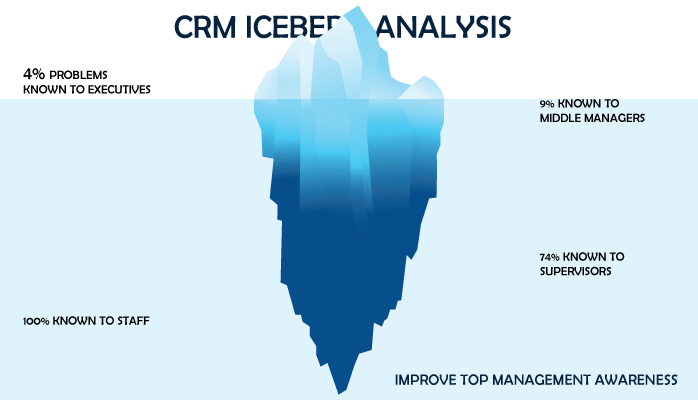What Is the Iceberg of Ignorance

The Iceberg of Ignorance was first developed in 1989 by a consultant named Sidney Yoshida. The Iceberg of Ignorance is a model that addressed concerns about safety awareness in large organizations. This model contends that of all problems:
- Only 4% of problems are known to upper managers;
- Only 9% of problems are known to middle managers;
- 74% of problems are known to supervisors; and
- 100% of problems are known to staff and front-line employees.
The idea is that management is only aware of the “tip of the iceberg.” This model has some rather obvious problems, namely that:
- Top managers will be aware of problems that staff has no idea about.
However, this model does identify the important fact that:
- Top managers are bound to be aware of high-level problems; but
- Not the many, many small problems that plague staff and eventually can lead to big problems.
Iceberg of Ignorance Reconstructed
In aviation SMS, this model is probably more useful when slightly reconstructed as being an awareness of quality vs. quantity:
- Top managers (decision makers) are aware of the few high-level problems but are not aware of the many minor issues;
- As we move down the latter, awareness of quality issues goes down, and awareness of quantifying goes up; and
- Staff are not necessarily aware of the high-level, trending problems, but are pointedly aware of the many minor problems that cause them problems every day.
This idea seems rather obvious: top managers are much more concerned with the “serious” problems, and front-line employees are concerned with the minor issues that cause frustration every day.
But the other reality is that most organizations simply don’t have a meaningful way for the “minor issues” to go all the way up the communication ladder for top managers to be aware of them.
These are important truths that lead to many preventable accidents and incidents every year.
Why Iceberg of Ignorance Matters in Risk Management

The reason the Iceberg of Ignorance (reconstructed) matters is because of one important point:
- All serious problems are the result of many smaller problems that go unnoticed or unmanaged.
One study found that for:
- Every serious incident;
- There were 59 smaller, “minor” incidents; and
- 600 minor conditions.
As decision-makers, if top managers can be more aware of the “minor” issues and conditions, they have the power to stop these issues/conditions before they lead to a serious incident. This is why the Iceberg of Ignorance matters to top managers and employees.
To overcome this issue:
- Top managers need to make a concerted effort to be aware of minor issues and conditions.
Overcoming this issue happens primarily through changing your hazard reporting system requirements.
Related Aviation Safety Manager Articles
- What Is a Safety Manager in Aviation Safety Management Systems (SMS)?
- How Optimized Record-Keeping Benefits Top Managers in Aviation
- 2 Reasons Top Safety Managers Fail in Aviation SMS
Overcome Iceberg of Ignorance Through Hazard Reporting
Overcome ignorance in your SMS requires:
- Having decision-makers be aware of minor problems;
- Having staff and front-line employees see the importance of minor problems; and
- Ensuring that front-line employees report these minor problems.
In real-world terms, it looks like this: all issues should be reported, even trivial concerns. Trivial concerns lead to bigger problems. Reporting all concerns requires a bit more work on the part of safety managers having to manage these issues. However, it ensures safety managers make decisions based on an awareness of all the data rather than just the ostensible problems.
Last updated in April 2025.





